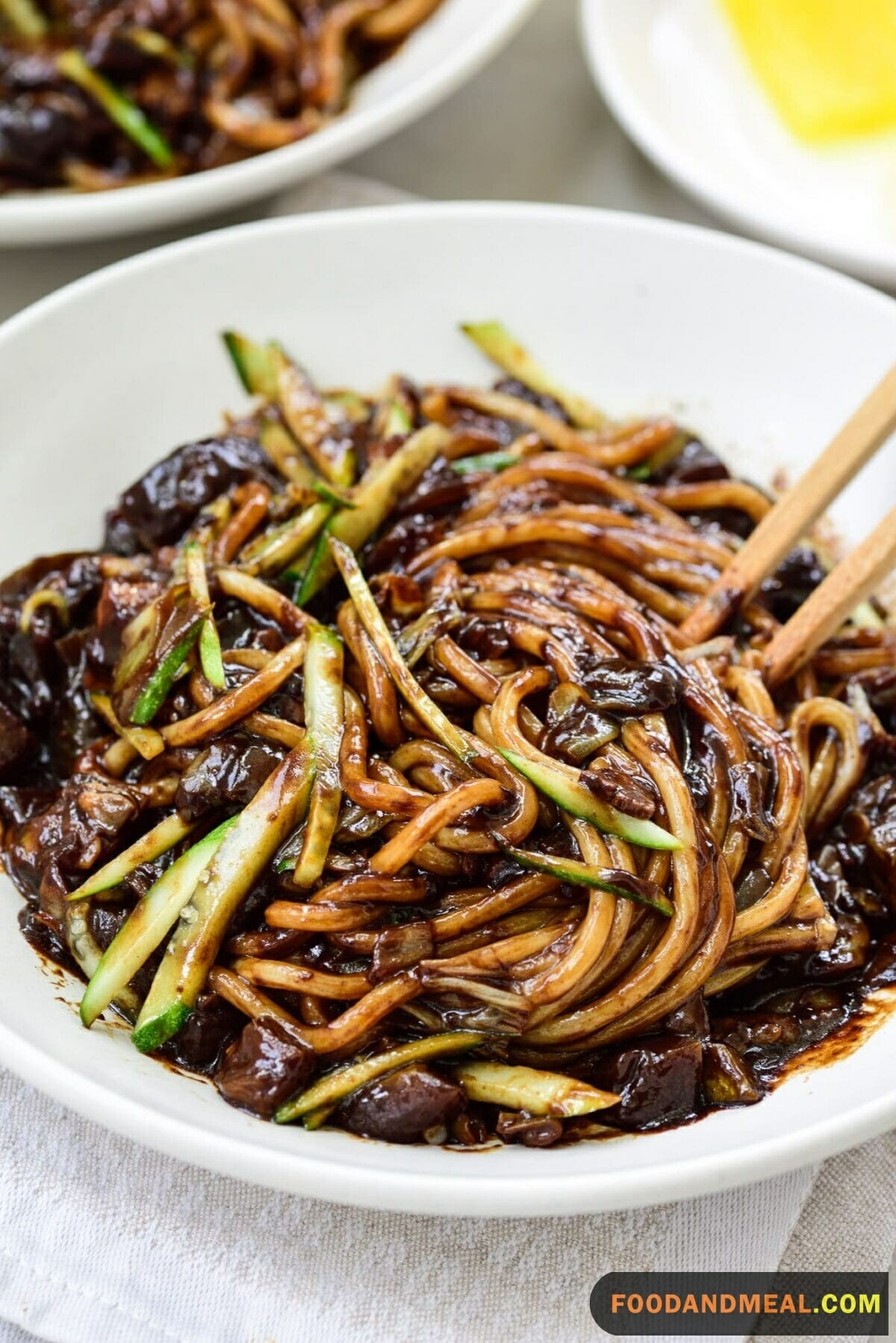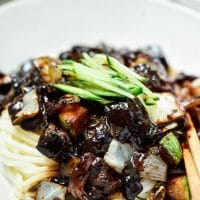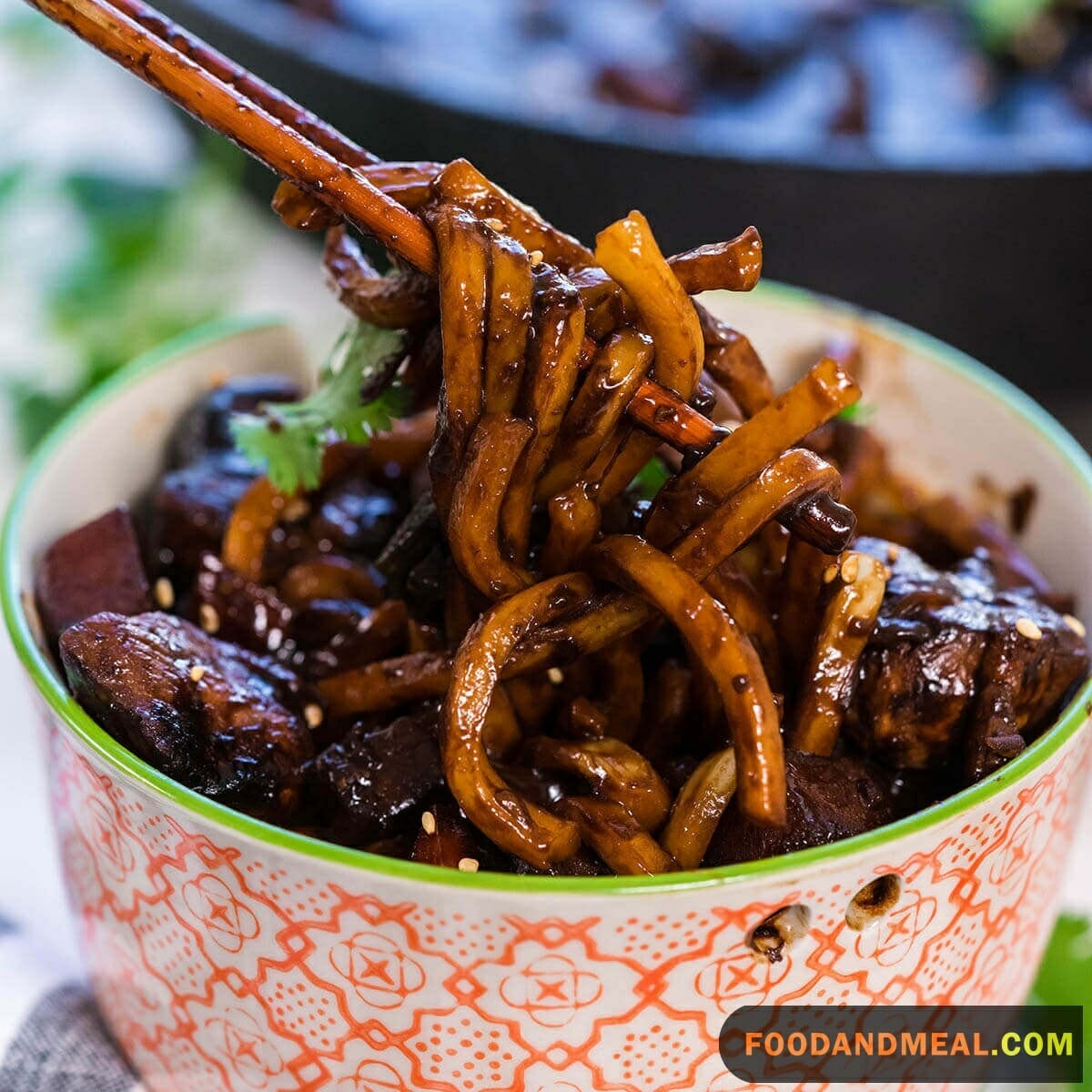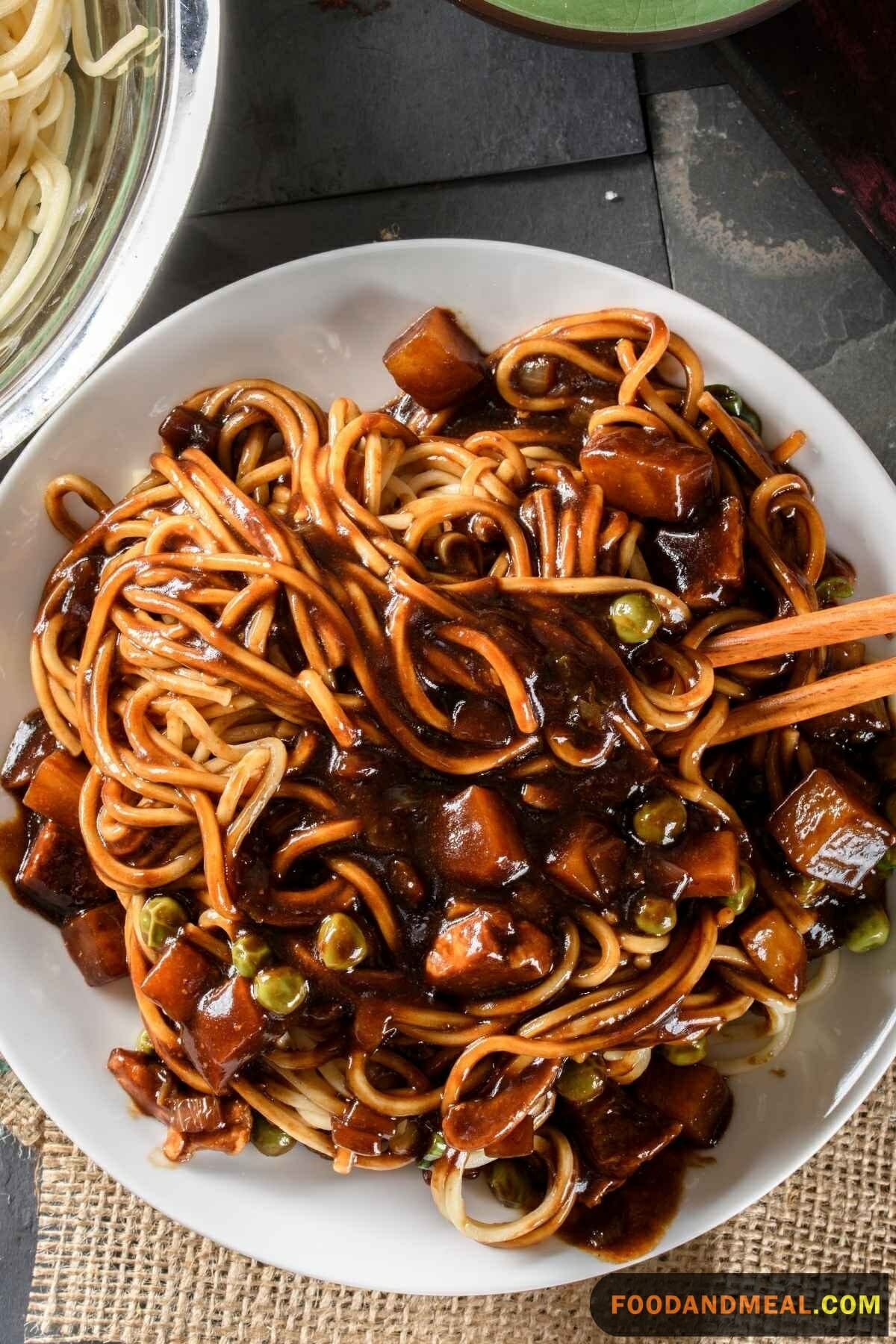As Nazia working at Food And Meal, I wanted to share a recipe for Korean-Chinese noodles in black bean sauce, known as jajangmyeon (자장면). This dish holds a special place in my heart, taking me back to childhood memories of savoring the sweet and savory sauce coating the chewy noodles.
I still recall the excitement I felt when a piping hot plate of jajangmyeon arrived at our table in a small family-owned Chinese restaurant. The thick, wheat flour noodles swimming in that glistening dark sauce always made my mouth water in anticipation of the first heavenly bite. Even now, when I close my eyes, I can practically taste the sweet and salty flavors dancing on my tongue.
There’s just something so comforting about a bowl of noodles coated in a flavorful sauce. And when you add the complex, almost caramel-like taste[2] of the black bean paste mixed with sautéed vegetables like onions, zucchini, and carrots, it takes this simple dish to a whole new level. I think that’s why I still feel drawn to making jajangmyeon at home these days. It fills my kitchen with those nostalgic aromas from the past.
With kids of my own now, I also love being able to pass down these food memories to the next generation. As I gently stir the sizzling ingredients in my wok, I tell my children the story of how their grandmother used to take me to our favorite Chinese restaurant as a special weekend treat. I describe the cozy little restaurant with the red lanterns lining the entrance as my kids listen with rapt attention.
When we finally sit down to enjoy the jajangmyeon I’ve prepared, I hope they feel the same sense of comfort, connection, and anticipation for that first tasty bite that I did all those years ago. This dish represents so much more than just noodles and sauce – it’s about bonding over warm meals and creating lasting food memories.

Korean-Chinese Noodles in Black Bean Sauce Recipe

KOREAN-CHINESE NOODLES IN BLACK BEAN SAUCE
Equipment
Ingredients
- 2 cups diced pork loin
- 4 medium potatoes, peeled and diced
- 2 teaspoons vegetable oil
- 2 medium sweet onions, diced
- 2 cups black bean paste (chunjang or jajang)
- 2 tablespoons toasted sesame oil
- 2 tablespoons minced garlic
- 1 tablespoon sugar
- 6 cups cool water, plus 1⁄2 cup
- 2 large carrots, peeled and cut into large dice
- 1 medium zucchini, diced
- 1/4 cup cornstarch
- 3 pounds Chinese flat, thick noodles (dry or fresh) or buckwheat, udon, or linguine noodles
- Sliced raw onions, for serving
- White vinegar, for serving
Instructions
- In a large skillet or wok, sauté the pork and potatoes in the vegetable oil for 2 to 3 minutes over high heat.
- Add the onions and sauté for 2 to 3 more minutes.
- Add the bean paste, sesame oil, garlic, and sugar and stir to mix. Sauté for 3 to 4 minutes.
- Add 6 cups of the water, the carrots, and zucchini, and bring to a boil. Reduce the heat to medium-low.
- In a small bowl, stir together the cornstarch with the remaining 1⁄2 cup water. Add the cornstarch slurry to the pan, stirring, to thicken the sauce. Cook until the vegetables are tender, about 15 minutes.
- Meanwhile, cook the noodles according to the package directions.
- To serve, place large mounds of noodles in big soup bowls. Ladle the sauce over the noodles. Place the sliced onions and the vinegar alongside.
Video
Notes
Nutrition
© Food And Meal
This website provides approximate nutrition information for convenience and as a courtesy only. Nutrition data is gathered primarily from the Spoonacular Database, whenever available, or otherwise other online calculators.
Cooking Tips for Korean-Chinese Noodles in Black Bean Sauce

I fondly remember watching the chef expertly stir-fry the ingredients in a hot wok, enveloping the kitchen in the sweet and savory aroma of caramelized onions, zucchini, and pork belly mingling with the deep, complex flavor of the black bean paste. Even now, just a whiff of those sizzling veggies and spices fills me with anticipation of the first tasty bite.
To recreate that restaurant-quality jajangmyeon at home, it’s important to prep all your ingredients before starting to cook. Have the pork belly or other protein thinly sliced, vegetables chopped, sauce mixed, and noodles boiled ahead of time. Once cooking starts, the process moves quickly, so you don’t want to be rushing around looking for ingredients.
When stir-frying, use very high heat and keep ingredients moving constantly. This helps vegetables like onion and zucchini caramelize while keeping the pork belly crispy on the edges. I also recommend adding the vegetables in batches so they cook evenly – start with the onions, then add carrots and zucchini.
Mixing the sauce well is also key to evenly coat the noodles later. Whisk together the black bean paste, brown sugar, ketchup, and broth vigorously until fully combined with no lumps. This step and constant stirring while simmering helps all the complex flavors of the sauce meld beautifully.
Finally, gently toss the piping hot noodles and stir-fried vegetables with the luscious sauce in batches. Coating each ingredient completely ensures every tasty, chewy, sweet and salty bite shines through in this soul-warming noodle dish.
Serving Suggestions for Korean-Chinese Noodles in Black Bean Sauce

I still recall the excitement I felt when a piping hot plate of jajangmyeon arrived at our table in a small family-owned Chinese restaurant. The thick, wheat flour noodles swimming in that glistening dark sauce always made my mouth water in anticipation of the first heavenly bite. Even now, when I close my eyes, I can practically taste the sweet and salty flavors dancing on my tongue.
There’s just something so comforting about a bowl of noodles coated in a flavorful sauce. And when you add the complex, almost caramel-like taste of the black bean paste mixed with sautéed vegetables like onions, zucchini, and carrots, it takes this simple dish to a whole new level. I think that’s why I still feel drawn to making jajangmyeon at home these days. It fills my kitchen with those nostalgic aromas from the past.
With kids of my own now, I also love being able to pass down these food memories to the next generation. As I gently stir the sizzling ingredients in my wok, I tell my children the story of how their grandmother used to take me to our favorite Chinese restaurant as a special weekend treat. I describe the cozy little restaurant with the red lanterns lining the entrance as my kids listen with rapt attention.
FAQs about Korean-Chinese Noodles in Black Bean Sauce

- What is Korean black bean sauce made from? Korean black bean sauce, known as Chunjang, is primarily made from fermented black soybeans, wheat flour, and caramel. It has a distinct savory and slightly sweet flavor, contributing to the rich taste of dishes like Jajangmyeon.
- What is Korean Chunjang? Korean Chunjang is a thick, dark, and savory black bean sauce used in various Korean dishes, with Jajangmyeon being the most popular. It is made through a fermentation process of black soybeans, giving it a unique umami flavor.
- Are Korean black bean noodles good? Yes, Korean black bean noodles, or Jajangmyeon, are widely enjoyed and appreciated for their rich, savory flavor. The combination of chewy noodles and the flavorful black bean sauce makes it a delicious and satisfying dish.
- Is Chinese black bean sauce the same as Korean? While both Chinese black bean sauce and Korean Chunjang share similarities, they are not identical. The flavor profiles may differ slightly due to variations in ingredients and preparation methods. Each cuisine has its unique twist on the sauce, creating distinct culinary experiences.
- What’s the origin of this dish? Jajangmyeon, as it’s traditionally called, traces its roots back to China. However, the Koreans adopted and adapted it, resulting in the unique fusion dish we relish today.
- Can I use spaghetti instead of traditional noodles?
While authentic Jajangmyeon uses chewy wheat noodles, spaghetti can be a practical substitute in a pinch. Just ensure it’s cooked al dente. - What if I don’t eat pork or beef?
Feel free to substitute with chicken, shrimp, or even tofu. The essence lies in the black bean sauce, and the protein can be modified as per preference. - How can I make it vegetarian?
Replace meat with an assortment of vegetables like bell peppers, zucchini, and mushrooms. The sauce’s richness will imbue them with flavors. - How do I store leftovers?
Separate the noodles from the sauce. Store each in airtight containers in the refrigerator for up to 3 days. When reheating, warm them separately and then combine to retain the best texture and flavor.
Conclusion
In conclusion, Korean-Chinese black bean noodles (jajangmyeon) hold a special place in my heart and taste buds. This soul-warming noodle dish instantly transports me back to childhood trips to our local Korean restaurant, where I eagerly awaited the arrival of a piping hot plate of chewy noodles swimming in that glistening dark sauce.
Even now, just a whiff of caramelized onions and pork belly sizzling with black bean paste fills me with anticipation for that first sweet and salty bite dancing on my tongue. Jajangmyeon truly brings people together over hearty, flavorful meals that create lasting food memories.
I hope this post on Food And Meal[1] has inspired you to give homemade Korean-Chinese noodles a try. With a few tips on preparing the ingredients and sauce ahead of time, you too can recreate that restaurant-quality flavor in your own kitchen. Serve it alongside some steaming miso soup, spicy kimchi stew, or pan-fried gyoza dumplings for the full Korean dining experience.
Hi! I'm Nazia of ‘Nazia Cooks’, a self-taught baker and cook residing in Chennai. Rooted in the rich South Indian culinary landscape, my palate has expanded to embrace global flavors. I revel in crafting fusion dishes, melding traditions to birth unique tastes.



